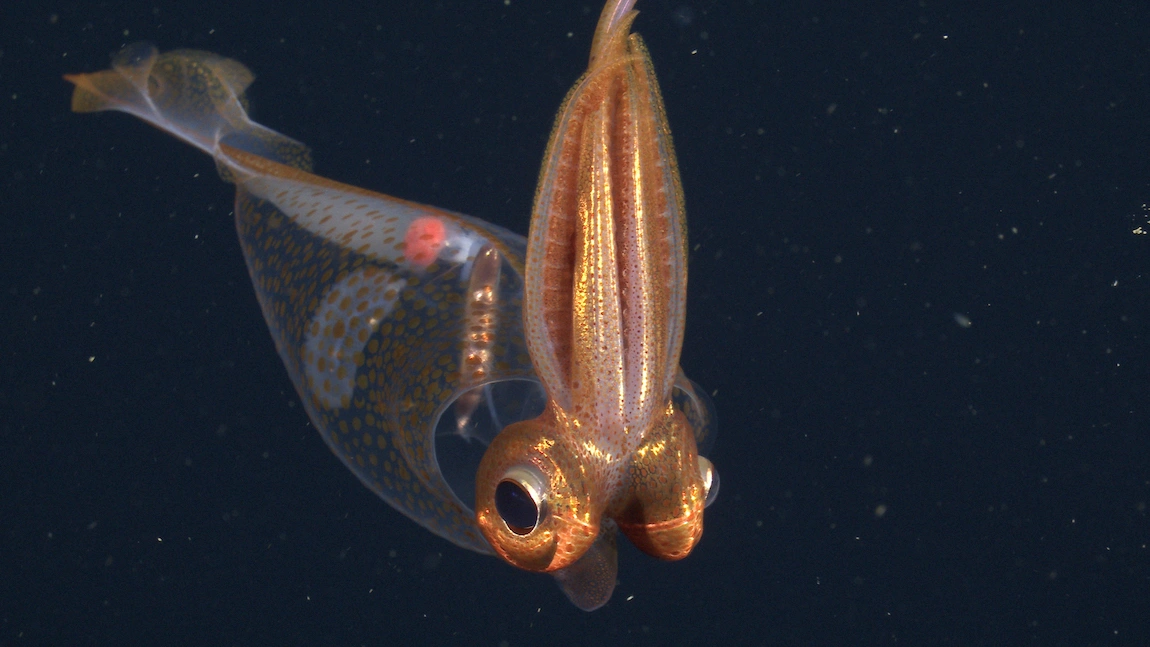Physical Address
304 North Cardinal St.
Dorchester Center, MA 02124

The glass squid, a creature of the deep ocean, is a marvel of nature’s ingenuity. With a body so transparent that it appears almost ghostly, the glass squid has developed remarkable adaptations that allow it to thrive in one of the most hostile environments on Earth. This article explores the unique characteristics of the glass squid, its fascinating abilities, and the evolutionary advantages of its transparency.
The most striking feature of the glass squid is its near-complete transparency. This adaptation serves as an extraordinary form of camouflage, allowing the squid to blend seamlessly into its surroundings. In the vast, dark depths of the ocean, where sunlight barely penetrates, being invisible is a significant advantage. Predators and prey alike struggle to spot the glass squid, giving it an edge in both hunting and evasion.
Unlike most marine animals that rely on color-changing cells called chromatophores, the glass squid’s transparency is a more passive form of disguise. Its internal organs are reduced and positioned to minimize their visibility, and its body is filled with a gelatinous substance that refracts light, making it nearly impossible to see. This adaptation is particularly useful in the midwater zone, where the squid’s transparency allows it to avoid detection by both predators from above and prey from below.
Transparency in the glass squid is not just for evasion; it also plays a crucial role in energy conservation. In the deep sea, where food is scarce, every bit of energy counts. By reducing the need for complex color-changing mechanisms, the glass squid conserves energy, which is essential for survival in such a resource-limited environment. Furthermore, its transparent body reduces drag as it moves through the water, allowing it to swim with greater efficiency.
While the glass squid’s transparency helps it stay hidden, it also possesses another remarkable adaptation: bioluminescence. Many species of glass squid have light-producing organs called photophores on their bodies. These photophores can emit light to confuse predators, attract mates, or even communicate with other squid. In the pitch-black environment of the deep sea, bioluminescence is a vital tool for survival.
The combination of transparency and bioluminescence creates a unique defense mechanism. The squid can flash its photophores to startle predators, then disappear into the darkness, leaving its would-be attacker disoriented. This dual strategy of invisibility and sudden illumination makes the glass squid a formidable survivor in the deep sea.
Glass squids inhabit the deep-sea environment, typically found at depths ranging from 200 to 1,000 meters. These depths are part of the mesopelagic and bathypelagic zones, where sunlight is minimal or nonexistent. In these regions, the pressure is immense, and temperatures are just above freezing. Despite these harsh conditions, the glass squid has adapted to thrive in this dark and cold world.
The deep sea is a mysterious place, and many aspects of the glass squid’s life remain unknown. However, what is known is that their transparent bodies are perfectly suited to this environment, allowing them to blend in with the faint light filtering down from above and the inky blackness below.
Like many deep-sea creatures, the reproductive habits of the glass squid are not well understood. However, it is believed that they follow a similar pattern to other cephalopods, laying eggs that hatch into small, transparent juveniles. These juveniles, like their adult counterparts, rely on their transparency to avoid predators as they grow.The lifespan of the glass squid is also relatively short, typical of cephalopods. This short lifespan means that they must reproduce quickly and efficiently to ensure the survival of their species. The exact details of their reproductive cycle remain a mystery, but researchers continue to study these elusive creatures to learn more.
The family contains two subfamilies (both established by Georg Johann Pfeffer) and about 15 genera:
The glass squid, with its transparent body and bioluminescent abilities, is a true marvel of the deep sea. Its adaptations have allowed it to thrive in one of the most challenging environments on Earth, where visibility is limited, and predators are ever-present. As we continue to explore the mysteries of the ocean, the glass squid stands out as a symbol of the incredible ingenuity of life and the ongoing need to protect our planet’s most vulnerable ecosystems. By understanding and preserving the glass squid, we take a step closer to unraveling the secrets of the deep sea and ensuring the survival of these extraordinary creatures for generations to come.